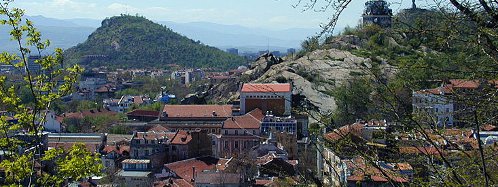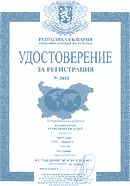Top offers







Plovdiv
The second biggest Bulgarian town is Plovdiv (about 400 000 inhabitants) and it is some 150 km away from Sofia.
The Maritsa River divides the town into two parts, which are interconnected by six bridges. The topography of this town is rather unusual. The lowland adjoining the town from the north is as flat as a table; and a group of rather high and steep detached hills. Another plain goes behind the hills till it finally reaches Rhodope Mountains. On these slopes and at the foot of these elevations lies Plovdiv, the town on six hills.
Plovdiv is a very ancient town. Nobody knows till now the exact date of its foundation. In 1975 the archaeologists discovered the remains of a religious building dating back to the Aegean (Cretan-Mycenaean) culture. It follows that Plovdiv emerged earlier than Athens, Rome, Constantinople. In the beginning there was a small Thracian settlement near tree of the hills. In the 6th century B.C. the town was conquered by Philippe II of Macedonia, who renamed the town after his dear self, Philippopolis. In the first century A.C. the Romans named the town Trimontium due to its unusual location. In medieval times Plovdiv was a Byzantine walled town. The Turks invaded it in 1364. the town flourished in the second part of the XIX century on the wave of the Bulgarian National Revival. Nowadays Plovdiv is an important economical and cultural centre.
Twice a year (in May and in September) the International Fair - Plovdiv is held there; Plovdiv also hosts many exhibitions and international festivals: the opera fest in the Amphitheatre (end of May – beginning of June), the International chamber music festival (in June), the Annual Verdi festival in the Amphitheatre (end of June), the international Folklore festival (beginning of August), International festival of puppet theatres and the National Autumn art exhibition “The old Plovdiv” (in September).
The Roman amphitheatre is the most renowned among the places of interest in Plovdiv; it is rather big, in its time it would hold about 6 thousand spectators. Although the memorial has not reached us in its entirety and good condition, for its age it looks great. Of Christian churches it would be of interest to see the Catholic Church (1861) – once it was the biggest in the Ottoman Empire, the St. Petka Church (1888), the St. Marina Metropolitan Cathedral (XIV century, reconstructed in 1851). There are also mosques in Plovdiv – Jumaya and Imaret (both of XIV century). To the west of the centre on the Bunarjik hill stands the 17-meters tall statue of Alyosha, the personification of the Soviet soldier who fought for the liberation of Bulgaria from the fascists.
It is extremely interesting to wander in the historic centre of Plovdiv; there are many buildings from the XIX century; some of them even have retained the authentic “renaissance” furniture. The paved with cobble roadways, the ancient ruins, the smart renaissance houses and finally the marvellous view from the hills, where the Old town of Plovdiv stands, all these are worth of our meticulous and close attention.
The second biggest Bulgarian town is Plovdiv (about 400 000 inhabitants) and it is some 150 km away from Sofia.
The Maritsa River divides the town into two parts, which are interconnected by six bridges. The topography of this town is rather unusual. The lowland adjoining the town from the north is as flat as a table; and a group of rather high and steep detached hills. Another plain goes behind the hills till it finally reaches Rhodope Mountains. On these slopes and at the foot of these elevations lies Plovdiv, the town on six hills.
Plovdiv is a very ancient town. Nobody knows till now the exact date of its foundation. In 1975 the archaeologists discovered the remains of a religious building dating back to the Aegean (Cretan-Mycenaean) culture. It follows that Plovdiv emerged earlier than Athens, Rome, Constantinople. In the beginning there was a small Thracian settlement near tree of the hills. In the 6th century B.C. the town was conquered by Philippe II of Macedonia, who renamed the town after his dear self, Philippopolis. In the first century A.C. the Romans named the town Trimontium due to its unusual location. In medieval times Plovdiv was a Byzantine walled town. The Turks invaded it in 1364. the town flourished in the second part of the XIX century on the wave of the Bulgarian National Revival. Nowadays Plovdiv is an important economical and cultural centre.
Twice a year (in May and in September) the International Fair - Plovdiv is held there; Plovdiv also hosts many exhibitions and international festivals: the opera fest in the Amphitheatre (end of May – beginning of June), the International chamber music festival (in June), the Annual Verdi festival in the Amphitheatre (end of June), the international Folklore festival (beginning of August), International festival of puppet theatres and the National Autumn art exhibition “The old Plovdiv” (in September).
The Roman amphitheatre is the most renowned among the places of interest in Plovdiv; it is rather big, in its time it would hold about 6 thousand spectators. Although the memorial has not reached us in its entirety and good condition, for its age it looks great. Of Christian churches it would be of interest to see the Catholic Church (1861) – once it was the biggest in the Ottoman Empire, the St. Petka Church (1888), the St. Marina Metropolitan Cathedral (XIV century, reconstructed in 1851). There are also mosques in Plovdiv – Jumaya and Imaret (both of XIV century). To the west of the centre on the Bunarjik hill stands the 17-meters tall statue of Alyosha, the personification of the Soviet soldier who fought for the liberation of Bulgaria from the fascists.
It is extremely interesting to wander in the historic centre of Plovdiv; there are many buildings from the XIX century; some of them even have retained the authentic “renaissance” furniture. The paved with cobble roadways, the ancient ruins, the smart renaissance houses and finally the marvellous view from the hills, where the Old town of Plovdiv stands, all these are worth of our meticulous and close attention.
Catalog of object in the resort
Museums
Places of interest
MICE (Meeting, Incentive, Conference, Events)
Bulgaria Destinations
Tourism news
© 2001 — 2025 | All rights reserved | created by format.bg



